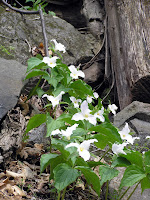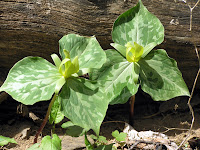
 Monday we rode up to Cumberland Gap National Historical Park. It was quite interesting to me, because about 45 years ago, on a weekend off, from taking a course on the use of radioisotopes in research at Oak Ridge, our family drove up and through Cumberland Gap.
Monday we rode up to Cumberland Gap National Historical Park. It was quite interesting to me, because about 45 years ago, on a weekend off, from taking a course on the use of radioisotopes in research at Oak Ridge, our family drove up and through Cumberland Gap. Pictures: Left, me, standing in the Gap
Right, overlooking the Gap from the pinnacle.
Things have changed a lot in 45 years! (It doesn’t seem that long to me.) In the first place one can drive within thirty miles or so of Cumberland Gap on a four-lane limited- access highway; whereas we had to take curvy mountain roads, at what might be considered a long time ago. But what is most amazing is the Cumberland Gap itself. When we drove there forty five years ago, a very busy, three-lane highway passed through Cumberland Gap, with no place to stop to view and to reflect on the significance of where we were. Now that highway has been eliminated and a tunnel , accommodating four lanes of traffic was constructed in 1995-96. Above the tunnel, the entire Gap has been converted into a wooded park, with only a hiking trail passing through the Gap. Well, actually there is also a railroad track, but it is well hidden. There is also a road to the pinnacle, overlooking the gap with a view of the surrounding area of three states: Kentucky, Tennessee, and Virginia.
A word or two about the historical significance of Cumberland Gap. Cumberland Gap has been an important route for the Indians across the Appalachian Mountains. This chain of mountains was a major impediment to westward migration from the colonies in pre-Revolutionary War Times. Daniel Boone was important explorer of the Kentucky area and frequently used the Cumberland Gap to enter the Kentucky frontier. Later he led a group that blazed the Wilderness Road through the Gap and this became a major thoroughfare for settlers into the Ohio River valley. During the Civil War, the Gap changed hands between the Union and Confederate Armies several times. Although this might have been an important route to supply the Union armies in Eastern Tennessee, generally it proved impractical. The route was too long, and in and weather made the roads too muddy. Livestock were driven over the route, but there was so little forage to consume on the way, the poor animals were nearly starved to death when the arrived at their destination, and hardly fit tobe slaughtered for food.
 A few notes on flowers. The iris we had seen and is pictured here is a crested dwarf iris. They stand about five inches off the ground, and have what appears to be three blooms in one, but is actually a single complicated bloom.
A few notes on flowers. The iris we had seen and is pictured here is a crested dwarf iris. They stand about five inches off the ground, and have what appears to be three blooms in one, but is actually a single complicated bloom.The mystery yellow flower turns out to be ragwort. Another picture appears here.












